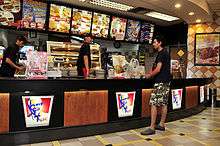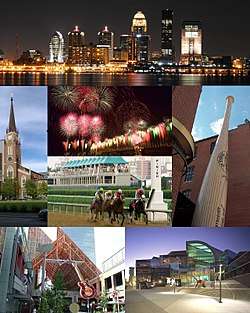KFC
KFC (short for Kentucky Fried Chicken)[6] is an American fast food restaurant chain headquartered in Louisville, Kentucky, that specializes in fried chicken. It is the world's second-largest restaurant chain (as measured by sales) after McDonald's, with 22,621 locations globally in 150 countries as of December 2019.[7] The chain is a subsidiary of Yum! Brands, a restaurant company that also owns the Pizza Hut, Taco Bell, and WingStreet chains.[8]
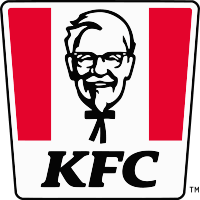 The KFC logo | |
| Subsidiary | |
| Industry | Restaurant |
| Genre | Fast food restaurant |
| Founded |
|
| Founder | Harland Sanders |
| Headquarters | 1441 Gardiner Lane Louisville, Kentucky, U.S. Dallas, Texas, U.S. (Global) |
Number of locations | 22,621[1][2] (2015) |
Key people | |
| Products |
|
| Revenue | US$23 billion (2013)[5] |
| Parent | Yum! Brands |
| Website | www |
KFC was founded by Colonel Harland Sanders, an entrepreneur who began selling fried chicken from his roadside restaurant in Corbin, Kentucky, during the Great Depression. Sanders identified the potential of the restaurant franchising concept, and the first "Kentucky Fried Chicken" franchise opened in Utah in 1952. KFC popularized chicken in the fast-food industry, diversifying the market by challenging the established dominance of the hamburger. By branding himself as "Colonel Sanders", Harland became a prominent figure of American cultural history, and his image remains widely used in KFC advertising to this day. However, the company's rapid expansion overwhelmed the aging Sanders, and he sold it to a group of investors led by John Y. Brown Jr. and Jack C. Massey in 1964.
KFC was one of the first American fast-food chains to expand internationally, opening outlets in Canada, the United Kingdom, Mexico, and Jamaica by the mid-1960s. Throughout the 1970s and 1980s, it experienced mixed fortunes domestically, as it went through a series of changes in corporate ownership with little or no experience in the restaurant business. In the early-1970s, KFC was sold to the spirits distributor Heublein, which was taken over by the R.J. Reynolds food and tobacco conglomerate; that company sold the chain to PepsiCo. The chain continued to expand overseas, however, and in 1987, it became the first Western restaurant chain to open in China. It has since expanded rapidly in China, which is now the company's single largest market. PepsiCo spun off its restaurants division as Tricon Global Restaurants, which later changed its name to Yum! Brands.
KFC's original product is pressure-fried chicken pieces, seasoned with Sanders' recipe of 11 herbs and spices.The constituents of the recipe are a trade secret. Larger portions of fried chicken are served in a cardboard "bucket", which has become a feature of the chain since it was first introduced by franchisee Pete Harman in 1957. Since the early-1990s, KFC has expanded its menu to offer other chicken products such as chicken fillet sandwiches and wraps, as well as salads and side dishes such as French fries and coleslaw, desserts, and soft drinks; the latter often supplied by PepsiCo. KFC is known for its slogans "It's Finger Lickin' Good!", "Nobody does chicken like KFC", and "So good".
History

Harland Sanders was born in 1890 and raised on a farm outside Henryville, Indiana (near Louisville, Kentucky).[9] When Sanders was five years old, his father died, forcing his mother to work at a canning plant.[10] This left Sanders, as the eldest son, to care for his two younger siblings.[10] After he reached seven years of age, his mother taught him how to cook.[9] After leaving the family home at the age of 13, Sanders passed through several professions, with mixed success.[11] In 1930, he took over a Shell filling station on US Route 25 just outside North Corbin, Kentucky, a small town on the edge of the Appalachian Mountains.[12] It was here that he first served to travelers the recipes that he had learned as a child: fried chicken and other dishes such as steaks and country ham.[12] After four years of serving from his own dining room table, Sanders purchased the larger filling station on the other side of the road and expanded to six tables.[13] By 1936, this had proven successful enough for Sanders to be given the honorary title of Kentucky colonel by Governor Ruby Laffoon.[14] In 1937 he expanded his restaurant to 142 seats, and added a motel he purchased across the street, naming it Sanders Court & Café.[15]
Sanders was unhappy with the 35 minutes it took to prepare his chicken in an iron frying pan, but he refused to deep fry the chicken, which he believed lowered the quality of the product.[16] If he pre-cooked the chicken in advance of orders, there was sometimes wastage at day's end.[9] In 1939, the first commercial pressure cookers were released onto the market, mostly designed for steaming vegetables.[17] Sanders bought one, and modified it into a pressure fryer, which he then used to fry chicken.[18] The new method reduced production time to be comparable with deep frying, while, in the opinion of Sanders, retaining the quality of pan-fried chicken.[16]
In July 1940, Sanders finalised what came to be known as his "Original Recipe" of 11 herbs and spices.[19] Although he never publicly revealed the recipe, he admitted to the use of salt and pepper, and claimed that the ingredients "stand on everybody's shelf".[20] After being recommissioned as a Kentucky colonel in 1950 by Governor Lawrence Wetherby, Sanders began to dress the part, growing a goatee and wearing a black frock coat (later switched to a white suit), a string tie, and referring to himself as "Colonel".[20] His associates went along with the title change, "jokingly at first and then in earnest", according to biographer Josh Ozersky.[21]
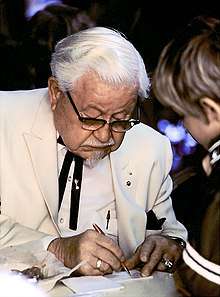
The Sanders Court & Café generally served travelers, so when the route planned in 1955 for Interstate 75 bypassed Corbin, Sanders sold his properties and traveled the US to franchise his chicken recipe to restaurant owners.[22] Independent restaurants would pay four (later five) cents on each chicken as a franchise fee, in exchange for Sanders' "secret blend of herbs and spices" and the right to feature his recipe on their menus and use his name and likeness for promotional purposes.[23] In 1952 he had already successfully franchised his recipe to his friend Pete Harman of South Salt Lake, Utah, the operator of one of the city's largest restaurants.[24]
Don Anderson, a sign painter hired by Harman, coined the name "Kentucky Fried Chicken".[25] For Harman, the addition of KFC was a way of differentiating his restaurant from competitors; a product from Kentucky was exotic, and evoked imagery of Southern hospitality.[25] Harman trademarked the phrase "It's finger lickin' good", which eventually became the company-wide slogan.[23] He also introduced the "bucket meal" in 1957 (14 pieces of chicken, five bread rolls and a pint of gravy in a cardboard bucket).[26] Serving their signature meal in a paper bucket was to become an iconic feature of the company.[26]
By 1963 there were 600 KFC restaurants, making the company the largest fast food operation in the United States.[22] KFC popularized chicken in the fast food industry, diversifying the market by challenging the established dominance of the hamburger.[27]
In 1964, Sanders sold the company to a group of investors led by John Y. Brown Jr. and Jack C. Massey for US$2 million (around US$15 million in 2013).[14] The contract included a lifetime salary for Sanders and the agreement that he would be the company's quality controller and trademark.[28] The chain had reached 3,000 outlets in 48 different countries by 1970.[29] In July 1971, Brown sold the company to the Connecticut-based Heublein, a packaged food and drinks corporation, for US$285 million (around US$1.6 billion in 2013).[30] Sanders died in 1980, his promotional work making him a prominent figure in American cultural history.[27] By the time of his death, there were an estimated 6,000 KFC outlets in 48 different countries worldwide, with $2 billion of sales annually.[31]
In 1982, Heublein was acquired by R. J. Reynolds, the tobacco giant.[26] In July 1986, Reynolds sold KFC to PepsiCo for $850 million (around US$1.8 billion in 2013).[32] PepsiCo made the chain a part of its restaurants division alongside Pizza Hut and Taco Bell.[33] The Chinese market was entered in November 1987, with an outlet in Beijing.[26]
In 1991, the KFC name was officially adopted, although it was already widely known by that initialism.[34] Kyle Craig, president of KFC US, admitted the change was an attempt to distance the chain from the unhealthy connotations of "fried".[35] The early 1990s saw a number of successful major products launched throughout the chain, including spicy "Hot Wings" (launched in 1990), popcorn chicken (1992), and internationally, the "Zinger", a spicy chicken fillet sandwich (1993).[36] By 1994, KFC had 5,149 outlets in the US, and 9,407 overall, with over 100,000 employees.[37] In August 1997, PepsiCo spun off its restaurants division as a public company valued at US$4.5 billion (around US$6.5 billion in 2013).[38] The new company was named Tricon Global Restaurants, and at the time had 30,000 outlets and annual sales of US$10 billion (around US$14 billion in 2013), making it second in the world only to McDonald's.[39] Tricon was renamed Yum! Brands in May 2002.[40]
By 2015, the company was struggling, having lost business to other retailers and being surpassed by Chick-fil-A as the leading chicken retailer in the U.S. three years previously. To combat this, the company launched a new initiative with a plan to revamp its packaging, decor and uniforms, as well as expanding its menu. Additionally, beginning in May 2015, a new series of advertisements was launched featuring Darrell Hammond as Colonel Sanders.[41] Subsequently, in a planned rotation of actors, Norm Macdonald, Jim Gaffigan, George Hamilton and Rob Riggle portrayed Sanders in similar ads through the fall of 2016. In January 2018, Country Music icon Reba McEntire was chosen to be KFC's first female Colonel Sanders.[42][43][44][45][46][47]
Operations
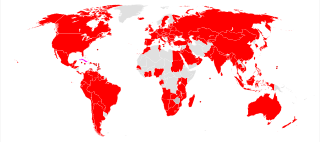

.png)
KFC is a subsidiary of Yum! Brands, one of the largest restaurant companies in the world. KFC had sales of $23 billion in 2013.[5] KFC has its headquarters at 1441 Gardiner Lane, Louisville, Kentucky, in a three-story colonial style building known colloquially as the "White House" due to its resemblance to the US president's home.[48][49] The headquarters contain executive offices and the company's research and development facilities.[50] KFC is incorporated at 1209 North Orange St, Wilmington, Delaware.[51]

By December 2013, there were 18,875 KFC outlets in 118 countries and territories around the world.[2] There are 4,563 outlets in China, 4,491 in the United States, and 9,821 across the rest of the world.[2] Outlets are owned by franchisees or directly by the company.[52] Eleven percent of outlets are company owned, with the rest operated by franchise holders.[53] Although capital intensive, company ownership allows for faster expansion of the chain.[54]
Most restaurants are furnished with images of the company founder, Colonel Harland Sanders.[50] As well as dine-in and take-out, many stand-alone KFC outlets offer a drive-through option.[55] KFC offers a limited delivery service in a small number of markets.[55] Units include express concessions and kiosks which feature a limited menu and operated in non-traditional locations such as filling stations, convenience stores, stadia, theme parks and colleges, where a full scale outlet would not be practical.[55] Average annual sales per unit was $1.2 million in 2013.[56] Worldwide, the daily average number of food orders at an outlet is 250, with most occurring within a two-hour peak-period.[57]
As a Director and CEO of Yum!, Greg Creed[3] ultimately has foremost responsibility for KFC operations. Sam Su is chairman and CEO of Yum!'s Chinese operations, and Tony Lowings is the president and CEO of KFC, replacing Roger Eaton who retired in 2018.[58] David Gibbs is president, CFO and COO of Yum! Brands, Inc.[3] On March 7, 2019 KFC announced a new executive position "Chief Communications Officer" and Staci Rawls will fill that position.[59]
Africa
The company hopes to expand its African operations, where it is already the regional leader among US fast food chains.[60][61] The company is slowly expanding across the African continent, opening 70 outlets, but progress has been hampered by sourcing issues, such as a lack of quality suppliers.[54] KFC first opened in Mauritius in 1981.
Asia
KFC is an major fast food restaurant in Asia.
In Sri Lanka, KFC was launched in 1995 at Majestic City. There were 25 KFC restaurants in Sri Lanka as of December 2014.[62]
In Singapore, the first KFC franchise was opened in 1977 along Somerset Road. In 1993, KFC Singapore was the first KFC in Asia to develop and launch the Zinger. KFC restaurants in Singapore are currently owned and operated by KFC (Malaysia) Holdings Bhd.[63]
In Bangladesh, the first KFC outlet was opened at Gulshan in 2006. As of June 2016, the country is home to 19 KFC outlets.[64][65]
In Cambodia, KFC first opened on Monivong Boulevard in Phnom Penh in 2008.[66]
In Myanmar, the first KFC outlet was officially opened on Bogyoke Aung San Road in Yangon in 2015.[67][68]
In the Philippines, KFC opened its first store in 1967. It's one of the few countries in the world where KFC has pasta on its menu.
In Taiwan, KFC entered the market in 1984 and opened its first store in 1985 in Taipei City. The 100th store in Taiwan opened in 1999. It was the second-largest fast-food chain restaurant in Taiwan until Mos Burger exceeded the number of branches of KFC in 2008. Now KFC is the third-largest fast-food chain restaurant with 137 stores as of 2017.[69]
Pakistan
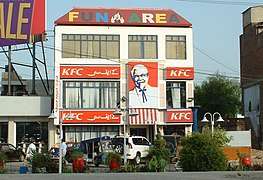
In Pakistan, first outlet of KFC was opened in Gulshan-e-Iqbal, Karachi in 1997.[70] But now KFC has a presence in 31 major cities of Pakistan with more than 92 outlets nationwide out of which 22 are in Karachi and 17 are in Lahore.[71]
KFC Pakistan menu consists of burgers, sandwiches, fried chicken, nuggets, fries, rice dishes, twister wraps and drinks.[70] KFC in Pakistan introduced a new food item named the "Zingeratha" which is a fusion of Zinger and Paratha, traditional food of Pakistan.[72]
China
KFC is the largest restaurant chain in China, with 5,003 outlets as of 2015.[73] They are operated by the Yum! China division. KFC became the first Western fast food company in China after its first outlet opened in Qianmen, Beijing, in November 1987.[74]
Local food items include rice congee and tree fungus salad, with an average of 50 different menu items per store.[74][75]
In December 2012, the chain faced allegations that some of its suppliers injected antiviral drugs and growth hormones into poultry in ways that violated food safety regulations.[76] This resulted in the chain severing its relationship with 100 suppliers, and agreeing to "actively co-operate" with a government investigation into its use of antibiotics.[74] KFC China sales in January 2013 were down 41 percent against the previous year.[77] To counter sluggish sales, the menu was revamped in 2014.[78]
In July 2014, Chinese authorities closed down the Shanghai operations of the OSI Group, amidst allegations that it had supplied KFC with expired meat.[79] Yum! immediately terminated its contract with the supplier, and stated that the revelation had led to a "significant [and] negative" decline in sales.[80]
India
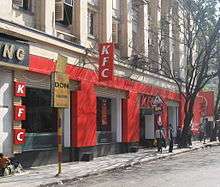

There are 350 KFC outlets in India.[73] The company has adapted the standard KFC offerings to Indian tastes[82] and the menu options in India include the Hot & Crispy Chicken and Fiery Grilled bucket options, Chicken Zinger, Krushers, Rice Bowlz and the more recently launched 5-in-1 Meal Box.[83] The business was refranchised in October 2015 after Yum concluded a year-and-a-half-long exercise to reorganize its business under larger, well-capitalized franchisees. In this regard, about a third of its outlets, operated by several of its franchisees, have been sold to a newly formed entity—Sapphire Foods India Pvt. Ltd. The new entity is owned by a consortium of four private equity funds, led by Samara Capital. The other investors are CX Partners, Goldman Sachs Group Inc. and a fourth fund, said a top executive at the local arm of the American food company.[84]
The first Indian KFC was a two-storey outlet on the fashionable Brigade Road in Bangalore in June 1995.[85] According to journalist Michael White, the company could not have chosen a "more difficult venue for its maiden entrée into the country".[86] Bangalore housed the headquarters of the Karnataka Rajya Raitha Sangha, one of the most influential, vocal and anti-foreign investment farmers' associations in the country.[86] The first outlet suffered protests from anti-globalisation and environmental campaigners, as well as local farmers, who objected to the chain bypassing local producers.[87] Many Indians were concerned about the onslaught of consumerism, the loss of national self-sufficiency, and the disruption of indigenous traditions.[88] The protests came to a head in August 1995, when the Bangalore outlet was repeatedly ransacked.[85] The KFC outlet in Bangalore demanded, and received, a police van permanently parked outside for a year.[87] The outlet was closed on September 13, 1995 by local authorities, who claimed the company used illegally high amounts of monosodium glutamate (MSG) in its food.[89] The outlet re-opened a few hours later as the result of an appeal by KFC to the Karnataka High Court. The company stated the recipe was no different than that used in any other KFC store.[90] Rural activist M. D. Nanjundaswamy claimed KFC would adversely affect the health of the impoverished, by diverting grain from poor people to make the more profitable animal feed.[91] Environmentalist Maneka Gandhi joined the anti-KFC movement.[91] A second outlet opened in Delhi, but was closed by the authorities throughout November, purportedly for health reasons, but more likely to avoid a repetition of the Bangalore incident.[92] The Delhi outlet soon closed permanently.[93]
KFC began to expand outside of Bangalore in 2004,[94] with a localized menu that was the most extensive meat-free menu across the chain's worldwide operations. It introduced a vegetarian menu that included rice meals, wraps and side dishes and, like McDonald's, served eggless mayonnaise and sauces. Unnat Varma, marketing director of KFC India, states "The vegetarian offerings have made the brand more relevant to a larger section of consumers and that is necessary for KFC's growth." KFC also began using Indian spices and cooking techniques to localize its chicken dishes. By 2008–09, KFC operated 34 outlets in India.[95] In 2014, KFC launched the "So Veg, So Good" menu as part of an India-specific promotional strategy focused on enhancing their vegetarian range. The company has been up to a lot of innovation over the past few months with the launch of the first-ever no crust, all chicken KFC Chizza in December 2016.[96] More recently, KFC got Mumbai's dabbawalas to deliver its newly launched 5-in-1 Meal Boxes. The city's dabbawalas, famed for their efficient delivery of office lunches, took on the role of KFC delivery men as part of an innovative marketing campaign. They supplied specially created 5-in-1 meal boxes to some office-goers instead of their regular dabbas.[97] The innovation efforts have continued with the launch of the Watt a Box, a practical new take on the 5-in-1 Meal Box, which can also charge phones.[98]
Indonesia
In Indonesia, KFC is the largest Western restaurant chain, with 466 outlets as of December 2013.[2][99] The chain has grown to hold an estimated 32 percent market share, and menu items include spaghetti, wraps and chicken porridge.[100] The master franchisee is PT Fastfood Indonesia.[101]
The first outlet opened in Jakarta in 1979.[101] Salim Group, Indonesia's largest conglomerate, became a major shareholder in 1990, which provided the company with funds for major expansion.[101] Its master franchisee, PT Fastfood Indonesia, was publicly listed on the Indonesian Stock Exchange in 1993.[101]
Japan
KFC Japan was formed in 1970 as a joint venture between the American parent and the Japanese Mitsubishi Corporation.[102] In December 1974, KFC Japan began to promote fried chicken as a Christmas meal.[103] Eating KFC at Christmas time has become a "Traditional Christmas Eve Dinner".[104][105] As of 2013, Japan is the third-largest market for KFC after China and the United States with 1,200 outlets.[106]
In December 2007, Mitsubishi assumed majority control of KFC Japan in a JP¥ 14.83 billion transaction.[107]
Malaysia
Being one of its largest overseas markets, the Malaysian KFC traces its origin from January 1, 1973 from its first outlet in Jalan Tunku Abdul Rahman, Kuala Lumpur.[108] In 2016, the brand has been crowned as the largest fast-food chain in Malaysia and dominating 45% of the local Fast-Food Market shares with its traditional rival, McDonald's following in second, while its sister restaurant, Pizza Hut spotting at the third place. By 2018, the restaurant has established a strong presence in the country, estimated to serve almost an equal proportion with the total population of Malaysia with 25 million customers every month by its 14,000 employees.[109][110]
_and_Chicken_Nuggets.jpg)
Similar to other international KFC markets, the Malaysian KFC also featuring various localized and seasonal food items in addition to the universal KFC Menu. The Malaysian KFC customarily offers two types of fried chicken: Original and Hot & Spicy, moreover, other types of fried chickens and food products are also being periodically introduced to the local consumers. Among other common year-long regional items unique to the Malaysian market includes colonel rice (derived from the local chicken rice), rice congee, popcorn chicken (offered in original and hot & spicy variants), wrap, cheesy potato wedges, gula melaka vanilla pudding, white coffee and teh tarik. Malaysians mostly prefer dark meat cuts, a divergent from the American KFC that observed white meat in higher demand. Furthermore, being a predominantly Muslim-country, all meats are slaughtered in accord to the Halal-method under the supervision of Shariah Advisory Council and the Department of Islamic Development Malaysia.
The KFC business design in Malaysian is generally offering a mid-range dining option to cater the predominantly middle-class Malaysian population. The premise is typically large in area and able to accommodate the dining culture commonly practiced among the Malaysian society, a contrast to the primarily takeout model seen in the American market. Many of the Malaysian KFC also operate round the clock, offering drive-through and delivery service.
As of 2018, QSR Brands (M) Holdings Bhd, the shareholder of the company in Malaysia is also responsible on managing 810 KFC outlets across Malaysia, Singapore, Brunei and Cambodia,[111] with more than 700 of these outlets are being located domestically in Malaysia, hence making the country one of the largest global market for the fast-food chain. The chain has been witnessed rapid expansion since the opening of its 250th Malaysian outlet on May 8, 1998 located in Petronas Twin Towers, the 500th branch in Subang launched on January 15, 2011, and the 700th restaurant in Seremban on September 18, 2018.[112][108]
Additionally, the QSR Brands is also in change on handling 380 Pizza Hut outlets in Malaysia and 80 in Singapore, similar to some international developments, many of these restaurants are being traditionally combined together with a KFC premise. The company is estimated earn MYR5 billion in revenue for KFC and Pizza Hut throughout the region in 2018, up from MYR4.56 billion (2017) and MYR4.24 billion (2016), the period recorded the company earned a profit of MYR182.98 million and MYR113.44 million in 2017 and 2016 respectively.[113][108]
In 1995, Projek Penyayang KFC was founded in an effort to provide food to more than 150 orphanages every quarter.[114] The social service by the restaurant was then extended by the introduction of Tabung Penyayang Fund in 1997, Add Hope Malaysia in 2006 and Add Hope Worldwide in 2007 as means to aid the local and international community.[115][116]
The chain is also one of the earliest fast-food eateries in Malaysia to employ people with different abilities from its outlet in Jalan Imbi, Kuala Lumpur on November 15, 1986 (has since relocated to Sentul Raya, Jalan Ipoh in 1992).[117][118] From the first fully operated KFC in the world run by speech-and hearing-impaired staff in Kuala Lumpur, the operation has expanded to its Malaysian operation in Tanjung Aru (Kota Kinabalu) and Saujana (Kuching) outlets in 1996.[119] Similarly, the model has also being adopted by several KFC eateries in Egypt, India, Pakistan, Singapore and Thailand. To date, the establishment has employed more than 350 Malaysian individuals predominantly of speech and hearing impairment.
KFC Malaysia is expected to have a 5% growth on sales in 2019. It has opened 23 outlets in 2018,[120][121] a further 36 outlets in 2019 and 30 eateries later in 2020.[110][121]
Europe
United Kingdom
As of December 2013, there were 784 KFC outlets in the United Kingdom.[2] British turnover was around £684.5 million in 2013, according to Technomic.[122] About 70 percent of outlets are run by franchisees, with the remainder company owned.[123] The company employs 24,000 people.[123] Around 400 sites are drive-through outlets.[123] Average outlet turnover is between £1 and £1.5 million.[123]
Annual sales amount to 60,000 metric tonnes of chicken, 60 percent of which is purchased from the four largest suppliers in the UK, including Faccenda Group[124] and 2 Sisters Food Group,[125][126] and delivered fresh to outlets at least three times a week.[127] The remaining 40 percent is sourced from companies in Europe, Thailand (including Charoen Pokphand Foods) and Brazil.[128] All of the Original Recipe chicken is sourced within the UK.[128]
England had the first overseas branch of KFC which opened in Preston, Lancashire in May 1965, and was the first American fast food restaurant chain in the country, pre-dating the arrival of McDonald's, Burger King and Pizza Hut by almost a decade.[129] Ray Allen, an experienced Lancashire caterer, was the first franchisee.[130] The first London branch opened in North Finchley in November 1968.[131] In 1971 there were 31 outlets; by 1975 the chain had grown to 250 outlets.[132] In the late 1970s and throughout the 1980s, KFCs began to introduce seating. KFC opened its first drive through restaurant in the UK in 1984.[133] By 1987 the company had almost 400 outlets.[134]
In May 1997, the "Tower Burger", a fried chicken fillet sandwich with the addition of a hash brown, was first launched in the United Kingdom.[135] In 2006, the company stopped pre-salting its fries and removed trans fats from its products.[123] In 2012 palm oil was replaced by rapeseed oil in the fryers.[123] Between 2004 and 2014, KFC UK increased its offering of "portable" foods: sandwiches, wraps and salads.[123] During that period, sales rose from around £500 million to almost £1 billion.[123] In 2012, KFC UK invested £9 million to install ovens in all of its outlets, so that it could offer griddled chicken.[123] In 2013, KFC rolled out Lavazza coffee across all of its UK outlets.[136] In February 2018, KFC had to temporarily close 575 of its UK outlets, and restrict menus and opening hours in other branches, as a result of its newly-contracted distributor, DHL, failing to deliver chicken to the outlets.[137] As of February 2019, KFC in the UK has around 110 restaurants that are Halal approved out of more than 900 units.[138] In March 2020, the restaurant announced that it would be closing all its stores temporarily, in response to lockdown measures during the COVID-19 outbreak.[139] On April 15, 2020, the store announced it would be reopening some stores for delivery services, as well as donating free meals to the NHS.[140]
Finland
KFC is planning on opening up to 50 franchise restaurants in 2019.[141]
Middle East
The first KFC in the Middle East opened in 1973 in Kuwait. Today there are over 700 outlets, certified halal, including the United Arab Emirates, Egypt, Qatar, Bahrain, Oman, Jordan, Lebanon, Morocco, Iraqi Kurdistan, and Saudi Arabia.[142] KFC Israel existed from 1993 to 2013 and featured kosher restaurants.[143] In December 2019 KFC has announced that it will be back to Israel until Christmas, planning to open dozens of restaurants by 2020. In 2012 KFC opened in Ramallah in the Palestinian Authority[8] and later expanded to Hebron,[9] Bethlehem,[10] Jenin,[11] and three separate outlets in Ramallah: the Ersal Branch (Bacri), Plaza Mall Branch and Masyoun Branch.[144] In 2013 the New York Times reported that KFC was being smuggled into Gaza through tunnels.[145][146]
North America
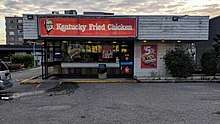
Canada
The first KFC opened in 1955 in Saskatoon, Canada.[147] In 1957, Colonel Harland Sanders gave an interview to CBC Radio[148] [lower-alpha 1] detailing his experience with Canadian food that led to the opening of one of his restaurants in Canada.
In Quebec, KFC is known as "PFK", due to provisions of the provincial government's Charter of the French Language that restrict use of English on signs and in business names.[149]
United States

KFC sales in the United States in 2013 were estimated at $4.22 billion by Technomic.[150]
The basic model for KFC in the United States, not necessarily duplicated elsewhere, is a focus on low prices, a limited menu (29 items on average) and an emphasis on takeout.[53] A "very strong percentage" of sales come from African American customers.[151] Many KFC locations are co-located with either Taco Bell or Pizza Hut, or other Yum! restaurants.[55] When Yum! owned Long John Silver's and A&W Restaurants, these brands were often co-branded with KFC as well.[152] Often these locations behave like a single restaurant, offering one menu with food items from both restaurant brands.[153] In 2003, there were 354 KFC-Taco Bell combines, offering the full KFC menu and Taco Bell items, and 13 units offering the full KFC menu and a limited number of Pizza Hut items.[55] The concept originated in 1991, when a KFC-Taco Bell combination opened in Virginia.[26] Some locations were also opened as combinations of KFC, Taco Bell and Pizza Hut, but this failed to catch on, and Yum! CEO David Novak blamed a lack of franchisee commitment for its lack of success.[154]
Initially, Sanders and KFC used hydrogenated vegetable oil for frying, but in the 1980s the company began to switch to cheaper oils such as palm or soybean.[155][156] In the 2000s it became apparent that these oils contain relatively high levels of trans fat, which increases the risk of heart disease. By April 2007, the chain had switched to trans fat-free soybean oil in all of its US outlets.[157]
In 2008, Novak credited low US sales as being the result of a lack of new ideas and menu items.[158] The Spring 2009 launch of Kentucky Grilled Chicken only resulted in a temporary halt to the sales decline.[159] In 2010 KFC announced a turnaround plan that included improving restaurant operations, introducing value items and providing healthier menu options.[159] In the same year, Advertising Age noted that KFC was losing market share to its smaller chicken restaurant rival, Chick-fil-A.[160] In 2011 Bloomberg News referred to KFC US as "an also-ran to McDonald's Corp".[161] In 2012, Forbes magazine described how many of the KFC outlets were "aged and uninviting", and that the chain "hasn't introduced an exciting new food item in ages".[162]
KFC was described in 2012 by Bloomberg Businessweek as a "muscular player" in developing regions, specifically Africa, China, and India while noting its falling market share in the US to rivals such as Chick-fil-A and Popeyes.[163] Some analysts speculated that KFC would begin spinning off its ailing US operations.[163] That year, the company began divesting control of company-owned US restaurants to franchised operations, with the intention of reducing overall company ownership from 35 percent to 5 percent.[163]
Mexico
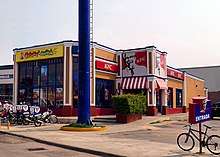
KFC was the first fast food restaurant opened in Mexico, in 1963 in Monterrey.[164] By 2017, there were 341 outlets in the country.[165]
Oceania
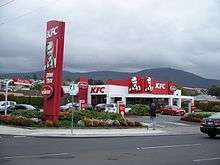
There are over 600 KFC outlets in Australia, and around 100 in New Zealand.[106] KFC was the first American style fast food chain to open in both countries.[166] In 2013, KFC reported an annual turnover of almost 2 billion AUD for its Australia and New Zealand operations.[167]
Australia
Yum! directly operates 160 KFC outlets in Australia.[167] The largest of the 53 independent franchisees in Australia is Collins Foods, which operates 169 stores.[167][168] KFC's major poultry suppliers in Australia are Inghams, Steggles and Turi Foods.[167]
The first Australian KFC was opened in 1968 in Guildford, a suburb of Sydney.[169] The franchise was owned by a Canadian entrepreneur called Bob Lapointe.[170] Between 1970 and 1971, 75 outlets were opened.[170] This had a major impact on Australian chicken production, which increased by 38 percent during the period.[170] By 1995 there were 452 outlets, and the company employed 12,000 staff.[169] That year, Australia produced 35 percent of KFC's international earnings.[169]
New Zealand
The first KFC opened in New Zealand in 1971 at Royal Oak, a suburb of Auckland.[171] By 1980 there were 37 outlets.[166] In 1989, PepsiCo acquired the 50 percent stake in KFC New Zealand that it did not already own from the local Goodman Fielder conglomerate.[171] In 1991 New Zealand turnover topped 100 million NZD for the first time.[171]
Products
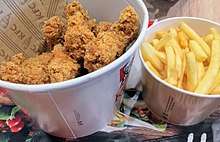

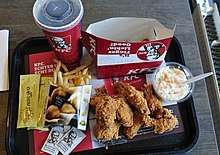

KFC's core product offering is pressure fried, on-the-bone chicken pieces seasoned with Colonel Harland Sanders' "Original Recipe" of 11 herbs and spices.[172] The product is typically available in either two or three piece individual servings, or in a family size cardboard bucket, typically holding between 6 and 16 chicken pieces. In territories that follow the system handed down by Colonel Sanders, such as Canada and the UK, each chicken is divided into nine different cuts (2 drumsticks, 2 thighs, 2 wings, 2 breast pieces and one keel),[173][174] however the United States now uses an eight piece cut.[175] The product is hand-breaded at individual KFC outlets with wheat flour mixed with seasoning in a two- to four-minute process.[57][167] It is then pressure fried for between seven and ten minutes (the timing differs between countries) in oil at 185 degrees Celsius.[57][176][177] Following this, the chicken is left to stand for 5 minutes in order for it to sufficiently cool before it is placed in the warming oven.[57] It is KFC policy to discard chicken if it has not been sold within 90 minutes, in order to ensure freshness.[57] The frying oil varies regionally, and versions used include sunflower, soybean, rapeseed and palm oil.[54] A KFC executive stated that the taste of the chicken will vary between regions depending on the oil variety used, and whether the chicken has been corn-fed or wheat-fed.[54]
As well as its core chicken on the bone offering, KFC's major products include chicken sandwiches (including the Zinger and the Tower); wraps ("Twisters" and "Boxmasters"); and a variety of finger foods, including crispy chicken strips and hot wings.[178][179] Popcorn Chicken is one of the most widely available KFC products, and consists of small pieces of fried chicken.[180] In some locations, such as in Australia and Malaysia, chicken nuggets are also sold.[181]
KFC adapts its menu internationally to suit regional tastes, and there are over three hundred KFC menu items worldwide.[53] Some locations, such as the UK and the US, sell grilled chicken.[182][183] In predominantly Islamic countries, the chicken served is halal.[57] In Asia there is a preference for spicy foods, such as the Zinger chicken sandwich.[184] Some locations in the US sell fried chicken livers and gizzards.[185] A small number of US outlets offer an all-you-can-eat buffet option with a limited menu.[186]
A number of territories, such as Japan, Jamaica, Trinidad, Barbados, Ecuador and Singapore sell fried seafood products under the "Colonel's Catch" banner.[187] In Jamaica, what was originally a seasonal offering for the Lent period was expanded to a year-round offering from 2010.[188]
Value menu items are sold under the "Streetwise" name in locations such as Canada.[189] Side dishes often include French fries, coleslaw, barbecue baked beans, corn on the cob, mashed potato, bread rolls and American biscuits.[190][191] Salads include the bean salad, the Caesar salad and the garden salad.[192] In a number of territories, KFC sell onion rings.[193] In Asia, rice based side dishes such as congee are often sold.[74] In the US and Greece, potato wedges are sold instead of French fries.[194]
McCormick & Company is KFC's largest supplier of sauces, seasonings, and marinades, and is a long-term partner in new product development.[167]
Due to the company's previous relationship with PepsiCo, most territories supply PepsiCo products, but exceptional territories include Barbados, Greece, New Zealand, the Philippines, Romania, South Africa, and Turkey, which stock drinks supplied by The Coca-Cola Company, and Aruba, which stocks RC Cola from the Cott Corporation.[195][196][197][198] In Peru, the locally popular Inca Kola is sold.[199] In a number of Eastern European locations and Portugal, beer is offered, in addition to soft drinks.[200][201][202]
Launched in 2009, the Krusher/Krushem range of frozen beverages containing "real bits" such as Kit Kat, Oreo and strawberry shortcake, is available in over 2,000 outlets.[203] Egg custard tart is a popular dessert worldwide, but other items include ice cream sundaes and tres leches cake in Peru.[204]
In 2012, the "KFC am" breakfast menu began to be rolled out internationally, including such items as pancakes, waffles and porridge, as well as fried chicken.[205][206]
On August 27, 2019, KFC tested meatless boneless wings and nuggets in Atlanta, Georgia.[207][208]
The 11 herbs and spices
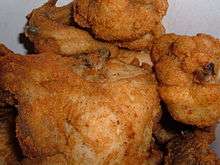
Sanders' Original Recipe of "11 herbs and spices" is one of the best known trade secrets in the catering industry.[209][210] The recipe is not patented, because patent law requires public disclosure of an invention and provides protection only for a strictly limited term, whereas trade secrets can remain the intellectual property of their holders in perpetuity.[211]
A copy of the recipe, signed by Sanders, is held inside a safe inside a vault in KFC's Louisville headquarters, along with eleven vials containing the herbs and spices.[163][212] To maintain the secrecy of the recipe, half of it is produced by Griffith Laboratories before it is given to McCormick, who add the second half.[213]
In 1999, a couple who bought the house formerly occupied by Colonel Sanders found scribbled notes purported to be the secret recipe. Initially, KFC wanted to file a lawsuit against the couple to stop an auction of the notes, but by early 2001, it dropped the lawsuit, claiming the scribbled notes are "nowhere close" to the original recipe.[214]
Joe Ledington of Kentucky, a nephew by marriage of Colonel Sanders, claimed to have found a copy of the original KFC fried chicken recipe on a handwritten piece of paper in an envelope in a scrapbook. In August 2016, Chicago Tribune staffers conducted a cooking test of this recipe and claimed after a few attempts that, with the addition of MSG flavor-enhancer, Ac'cent, they produced fried chicken which tasted "indistinguishable" from the chicken they purchased at KFC.[215]
Equipment
KFC initially used stove-top covered cooking pots to fry its chicken.[216] In the 1960s, the officially recommended model was the L S Hartzog developed "KFC 20-Head Cooker", a large device that cost $16,000.[217] The Hartzog model had no oil filtration system, meaning that filtering had to be done manually, and the pressure fryers occasionally exploded, often causing harm to employees.[216] In 1969, inventor and engineer Winston L. Shelton developed the "Collectramatic" pressurized fryer to overcome the problems KFC faced in quickly frying chicken to meet growing customer demand. The Collectramatic used precision time and temperature controls and self-filtered the cooking oil – all while meeting Colonel Sanders' high standards.[216] Fred Jeffries, then vice president of purchasing at KFC, claimed that the invention helped fuel the company's rapid expansion and success:
There's no way it (KFC) could have grown as it did without the Collectramatic. Stores were doing about $200,000 a year in sales on average with the pots ... but they could never have done the $900,000 a year it became without Win's fryer. He (Shelton) helped set the stage for that with true engineering thinking.[216]
Although a number of franchisees bought the Collectramatic, which had the support of Colonel Sanders from 1970 onwards, John Y. Brown had given tacit approval to franchisees to exclusively use the older L S Hartzog fryer, saying "Though those old pots were damn dangerous, at least we knew they worked! I was mostly afraid these new fryers would break down in the middle of business."[216] Brown warned franchisees that they were in violation of their contract if they used the Collectramatic.[216] Brown held his ground on the issue until he learned that his father, John Y. Brown Sr., who owned multiple KFC franchises, was successfully using the Collectramatic in every franchise he owned.[216] The issue was eventually resolved after Heublein purchased KFC, acquired Hartzog and nullified the contract.[217] The Collectramatic has been an approved pressure fryer for KFC from 1972 onwards.[217]
From 2013 onwards, KFC has been transitioning from using Collectramatic cookers to pressure fryers produced by Henny Penny, which supplies KFC with various equipment.[218] The 'Velocity' series of pressure fryers includes increased load capacity, automatic oil filtration and increased oil longevity.
Advertising
Colonel Sanders was a key component of KFC advertising until his death in 1980. Despite his death, Sanders remains a key icon of the company as an "international symbol of hospitality".[219] Early official slogans for the company included "North America's Hospitality Dish" (from 1956) and "We fix Sunday dinner seven nights a week".[220][221] The "finger lickin' good" slogan was used from 1956, and went on to become one of the best-known slogans of the 20th century.[222] The trademark expired in the US in 2006.[223] The first KFC logo was introduced in 1952 and featured a "Kentucky Fried Chicken" typeface and a logo of the Colonel.[224] In 1962, Dave Thomas took Colonel Sanders' Bucket and turned it into a sign[225] that revolved in a circular motion in front of almost every KFC.[226]
Advertising played a key role at KFC after it was sold by Sanders, and the company began to advertise on US television with a budget of US$4 million in 1966.[227] In order to fund nationwide advertising campaigns, the Kentucky Fried Chicken Advertising Co-Op was established, giving franchisees ten votes and the company three when deciding on budgets and campaigns. In 1969, KFC hired its first national advertising agency, Leo Burnett.[26] A notable Burnett campaign in 1972 was the "Get a bucket of chicken, have a barrel of fun" jingle, performed by Barry Manilow.[26] By 1976 KFC was one of the largest advertisers in the US.[228]
Controversies and criticism
Since the beginning of the 21st century, fast food has been criticized for its animal welfare record, its links to obesity and its environmental impact.[229] Eric Schlosser's book Fast Food Nation (2002) and Morgan Spurlock's film Super Size Me (2004) reflected these concerns.[25] Since 2003, People for the Ethical Treatment of Animals (PETA) has protested KFC's choice of poultry suppliers worldwide.[230] The exception is KFC Canada, which signed an agreement pledging to only use "animal friendly" suppliers.[231] President of KFC's US division Gregg Dedrick said PETA mischaracterized KFC as a poultry producer rather than a purchaser of chickens.[232] In 2008, Yum! stated: "[As] a major purchaser of food products, [Yum!] has the opportunity and responsibility to influence the way animals supplied to us are treated. We take that responsibility very seriously, and we are monitoring our suppliers on an ongoing basis."[233]
In 2006, Greenpeace accused KFC Europe of sourcing the soya bean for its chicken feed from Cargill, which had been accused of clearing large swathes of the Amazon rainforest in order to grow the crop.[234]
In 2010, according to The Guardian, "in the US where fried chicken remains closely associated with age-old racist stereotypes about black people in the once segregated south", KFC Australia aired the thirty-second promotion on television named "KFC's cricket survival guide" which shows a cricket fan surrounded by fans from the opposing team. The television announcer asks, "Need a tip when you're stuck in an awkward situation?" the fan passes around his "bucket of KFC", even though the commercial was intended for an Australian audience, of which found its way to social media in the United States, prompting sharp disapproval. KFC Australia made a statement to the fact the commercial was "misinterpreted by a segment of people in the US" and it was a "light-hearted reference to the West Indian cricket team" and "The ad was reproduced online in the US without KFC's permission, where we are told a culturally-based stereotype exists, leading to the incorrect assertion of racism... We unequivocally condemn discrimination of any type and have a proud history as one of the world's leading employers for diversity".[235]
In May 2012, Greenpeace accused KFC of sourcing paper pulp for its food packaging from Indonesian rainforest wood.[236] Independent forensic tests showed that some packaging contained more than 50 percent mixed tropical hardwood fiber, sourced from Asia Pulp & Paper (APP).[237][238] APP said such fiber can be found in recycled paper, or: "It can also come from tree residues that are cleared, after a forest area has become degraded, logged-over or burned, as part of a sustainable development plan. APP has strict policies and practices in place to ensure that only residues from legal plantation development on degraded or logged-over forest areas and sustainable wood fiber enters the production supply chain."[237] KFC said: "From a global perspective, 60 percent of the paper products that Yum! (our parent company) sources are from sustainable sources. Our suppliers are working towards making it 100 percent."[236]

In December 2012, the chain was criticized in China when it was discovered that a number of KFC suppliers had been using growth hormones and an excessive amount of antibiotics on its poultry in ways that violated Chinese law.[239] In February 2013, Yum! CEO David Novak admitted that the scandal had been "longer lasting and more impactful than we ever imagined."[239] The issue is of major concern to Yum!, which earns almost half of its profits from China, largely through the KFC brand. In March 2013, Yum! reported that sales had rebounded in February, but that lower sales in December and January would result in a decline in same-store sales of 20 percent in the first quarter.[240]
In 2017, KFC was fined £950,000 after two workers in the UK were scalded by boiling hot gravy. The company admitted to charges of failing in a duty of care to employees, and was ordered by Teesside Crown Court to pay fines of £800,000 and £150,000.[241]
In February 2018, logistics mismanagement by DHL, which had been selected by KFC UK as their new delivery partner, caused a chicken shortage in the United Kingdom – KFC's largest market in Europe – forcing the company to temporarily close hundreds of restaurants around the country.[242] KFC apologized by taking out adverts in British newspapers with the company's initials scrambled to read "FCK" on it followed by an apology, which was well received.[243]
See also
- Cuisine of the Southern United States
- List of fast-food chicken restaurants
- List of fast food restaurant chains
- List of major employers in Louisville, Kentucky
References
- http://investors.yum.com/Cache/396825367.pdf
- "Restaurant counts" (PDF). Yum! Brands. p. 111. Retrieved September 1, 2016.
As of year end 2015, KFC had 5,003 units in China, 372 units in India and 14,577 units within the KFC Division.
- "Senior Officers & Leadership Team". Yum! Brands. Retrieved May 15, 2019.
- Luna, Nancy (May 13, 2019). "KFC promotes Monica Rothgery to COO of U.S. division". Nation's Restaurant News. Retrieved May 15, 2019.
- Iconic Global Brand (PDF). Louisville: Yum! Brands. 2014. p. 98. Retrieved September 1, 2016.
- Keyser, Hannah (October 27, 2015). "12 Finger-Lickin' Facts About KFC - 8. "KFC" Doesn't Stand For Anything. Technically". Mental Floss. Retrieved January 2, 2020.
- "KFC: restaurants worldwide 2019". Statista. Retrieved May 14, 2020.
- "YUM! Brands, Form 10-K, Annual Report, Filing Date Feb 22, 2018". secdatabase.com. Retrieved May 3, 2018.
- Whitworth, William (February 14, 1970). "Kentucky-Fried". The New Yorker. Retrieved February 23, 2013.
- Klotter, James C. (2005). The Human Tradition in the New South. Rowman & Littlefield. p. 129. ISBN 978-0-7425-4476-5. Retrieved June 29, 2013.
- Sanders, Harland (2012). The Autobiography of the Original Celebrity Chef (PDF). Louisville: KFC. p. 15. Archived from the original (PDF) on September 21, 2013.
- Ozersky, Josh (April 2012). Colonel Sanders and the American Dream. University of Texas Press. pp. 19–24. ISBN 978-0-292-74285-7. Retrieved September 27, 2013.
- Aaseng, Nathan (January 2001). Business Builders in Fast Food. Oliver Press. p. 116. ISBN 978-1-881508-58-8. Retrieved March 13, 2013.
- Smith, Andrew F. (December 2, 2011). Fast Food and Junk Food: An Encyclopedia of What We Love to Eat. ABC-CLIO. p. 612. ISBN 978-0-313-39394-5.
- Hollis, Tim (1999). Dixie Before Disney: 100 Years of Roadside Fun. University Press of Mississippi. pp. 19–20. ISBN 978-1-61703-374-2.
- Sanders, Harland (1974). The Incredible Colonel. Illinois: Creation House. pp. 98–131. ISBN 978-0-88419-053-0.
- Binney, Ruth (April 1, 2012). Wise Words and Country Ways for Cooks. David & Charles. p. 202. ISBN 978-0-7153-3420-1.
- Grimes, William (August 26, 2012). "In Kentucky, Fried Chicken History". New York Times. Retrieved September 27, 2013.
- Schreiner, Bruce (July 23, 2005). "KFC still guards Colonel's secret". Associated Press. Archived from the original on November 6, 2013. Retrieved September 19, 2013.
- Kleber, John E. (May 18, 1992). The Kentucky Encyclopedia. University Press of Kentucky. p. 796. ISBN 978-0-8131-2883-2. Retrieved March 13, 2013.
- Ozersky, Josh (2012). Colonel Sanders and the American Dream. University of Texas Press. p. 25. ISBN 978-0-292-74285-7. Retrieved April 7, 2013.
- John A. Jakle; Keith A. Sculle (1999). Fast Food: Roadside Restaurants in the Automobile Age. JHU Press. p. 219. ISBN 978-0-8018-6920-4. Retrieved March 13, 2013.
- Liddle, Alan (October 14, 1996). "Leon W. 'Pete' Harman: the operational father of KFC has many goals — and retiring isn't one of them". Nation's Restaurant News. Archived from the original on May 8, 2013. Retrieved July 1, 2012.
- Patty Henetz; Jenifer K. Nii (April 21, 2004). "Colonel's landmark KFC is mashed". Deseret Morning News. Retrieved November 13, 2013.
- Liddle, Alan (May 21, 1990). "Pete Harman". Nation's Restaurant News.
- Darden, Robert (January 1, 2004). Secret Recipe: Why Kfc Is Still Cooking After 50 Years. Tapestry Press. pp. 12, 57–58, 101, 159, 175, 211. ISBN 978-1-930819-33-7.
- Smith, Andrew F. (May 1, 2007). The Oxford Companion to American Food and Drink. Oxford University Press. p. 341. ISBN 978-0-19-530796-2. Retrieved March 11, 2013.
- Cottreli, Robert (December 17, 1980). "Obituary: Colonel Sanders". Financial Times.
- Aaseng, Nathan (January 1, 2001). Business Builders in Fast Food. The Oliver Press, Inc. p. 125. ISBN 978-1-881508-58-8. Retrieved March 13, 2013.
- Barmash, Isadore (July 23, 1971). "Chief Expected to Leave Kentucky Fried Chicken". New York Times.
- Smith, J. Y. (December 17, 1980). "Col. Sanders, the Fried-Chicken Gentleman, Dies". The Washington Post.
- Stevenson, Richard W. (July 25, 1986). "Pepsico to Acquire Kentucky Fried: Deal Worth $850 Million". New York Times.
- Brooks, Nancy Rivera (July 25, 1986). "Pepsico to Buy Kentucky Fried From RJR Nabisco – $850-Million Deal Is Good for Both Firms-Analysts". Los Angeles Times. Retrieved June 30, 2012.
- Seth Stevenson (May 3, 2004). "Alphabet Soup". Slate. Retrieved June 28, 2012.
- "And Now, Finger Lickin' Good For Ya?". Businessweek. February 17, 1991. Retrieved February 5, 2013.
- "A feast of bargains". Sunday Herald Sun. May 31, 1992.
- John A. Jakle; Keith A. Sculle (1999). Fast Food: Roadside Restaurants in the Automobile Age. JHU Press. p. 221. ISBN 978-0-8018-6920-4. Retrieved March 11, 2013.
- "Pepsico To Tricon". Chicago Tribune. October 7, 1997. Retrieved September 27, 2013.
- "Pepsico Picks Name For Planned Spinoff". New York Times. June 28, 1997. Retrieved September 27, 2013.
- "Tricon Global Restaurants Shareholders Approve Company Name Change to Yum! Brands, Inc". QSR Magazine. May 16, 2002. Retrieved November 20, 2013.
- Harwell, Drew (May 25, 2015). "The fried-chicken wars: Inside KFC's weird new fight to dethrone Chick-fil-A". The Washington Post. Archived from the original on May 26, 2015. Retrieved May 27, 2015.
- "CMO Q&A: How KFC's Colonel Sanders reboot 'broke the Internet' - twice". January 27, 2016. Retrieved February 7, 2016.
- "KFC has 'Last Comic Standing' judge Norm Macdonald as new Colonel - Business Insider". Business Insider. August 17, 2015.
- Johnson, Lauren (February 6, 2016). "KFC Swaps Out Norm Macdonald for Jim Gaffigan as Its Latest 'Real' Colonel". Adweek. Retrieved August 23, 2016.
- Moran, Victoria (June 23, 2016). "KFC Brings in an Extra-Bronzed George Hamilton to Play Extra Crispy Colonel". Advertising Age. Retrieved August 23, 2016.
- "KFC Debuts a New Colonel For Football Season". Fortune. September 8, 2016. Retrieved September 10, 2016.
- "Reba McEntire to play KFC's Colonel Sanders". CBS News. January 26, 2018.
- Kleber, John E. (December 4, 2000). The Encyclopedia of Louisville. University Press of Kentucky. p. 482. ISBN 978-0-8131-2100-0. Retrieved September 11, 2012.
- Wolf, Barney (May 2012). "David Novak's Global Vision". QSR Magazine. Archived from the original on March 9, 2014. Retrieved April 3, 2014.
- "Yum! Brands 10K 31/12/2011". Yum! Brands. Retrieved March 24, 2013.
- Thimmesch, Adam B. (2011–2012). "The Fading Bright Line of Physical Presence: Did KFC Corporation v. Iowa Department of Revenue Give States the Secret Recipe for Repudiating Quill?". Kentucky Law Journal. 100: 339–389.
- Jing, Jun (2000). Feeding China's Little Emperors: Food, Children, and Social Change. Stanford University Press. p. 123. ISBN 978-0-8047-3134-8. Retrieved September 27, 2013.
- David E. Bell; Mary L. Shelman (November 2011). "KFC's Radical Approach To China". Harvard Business Review. Retrieved January 31, 2013.
- Steyn, Lisa (June 21, 2013). "KFC's secret recipe for growth". Mail & Guardian. Retrieved September 26, 2013.
- Cartwright, Roger (October 31, 2003). Implementing a Training and Development Strategy: Training and Development 11.8. John Wiley & Sons. p. 42. ISBN 978-1-84112-494-0.
- Novak, David (March 2014). Recognizing the Power of Yum!. Yum!. p. 9.
- Stephens Balakrishnan, Melodena (2013). East Meets West: the World is Round and Time is Cyclic. Emerald Group Publishing. pp. 126–132. ISBN 978-1-78190-413-8.
- Maze, Jonathan (September 28, 2018). "Tony Lowings to replace Roger Eaton as KFC CEO". Restaurant Business. Retrieved May 15, 2019.
- Luna, Nancy (March 7, 2019). "KFC names first chief communications officer". Nations Restaurant News. Retrieved March 8, 2019.
- "KFC to Expand Steadily Into Africa". KFC South Africa. Retrieved January 28, 2013.
- Nakkas, Laurel (February 2013). "Africa: The Final Frontier?". QSR Magazine. Retrieved March 13, 2013.
- KFC - Kentucky Fried Chicken, http://www.cargillsceylon.com/OurBusinesses/KFC.aspx
- "About Us Milestone". KFC Singapore. Archived from the original on April 28, 2016. Retrieved August 23, 2016.
- "KFC opens new outlet in Mirpur #2". The Daily Star. June 20, 2016. Retrieved July 20, 2016.
- "Transcom Foods Ltd". transcombd.com. Archived from the original on December 31, 2014. Retrieved September 9, 2015.
- "KFC History". kfc.com.kh. Retrieved September 9, 2015.
- Mullins, Jeremy (May 6, 2015). "KFC's first location will be on Bogyoke Aung San Road". The Myanmar Times. Retrieved September 9, 2015.
- Taylor, Adam (July 1, 2015). "Myanmar gets its first taste of KFC". The Salt Lake Tribune. Retrieved September 9, 2015.
- "線上訂餐免出門-肯德基www.kfcclub.com.tw". www.kfcclub.com.tw.
- "KFC Pakistan – About Us". Retrieved April 15, 2017.
- https://www.kfcpakistan.com/page/location
- KFC Zingeratha - Do Ka Fusion, retrieved November 22, 2019
- "KFC India Official Site". yum.com. Retrieved April 17, 2016.
- Kaiman, Jonathan (January 4, 2012). "China's fast-food pioneer struggles to keep customers saying 'YUM!'". The Guardian. London. Retrieved January 4, 2012.
- Shen, Samuel (May 5, 2008). "Kentucky Fried Chicken banks on China". New York Times. Retrieved September 11, 2012.
- Waldmeir, Patti (December 20, 2012). "Yum investigates poultry allegations". Financial Times. London.
- Coonan, Clifford (February 12, 2013). "Scare takes bite out of KFC's sales". The Irish Times. Dublin. Archived from the original on February 13, 2013. Retrieved February 12, 2013.
- Wong, Venessa (March 27, 2014). "To Start Fresh in China, KFC Goes for a Menu Makeover". Businessweek. Retrieved March 28, 2014.
- Hornby, Lucy (July 21, 2014). "McDonald's and KFC hit by China food safety scandal". Financial Times. London. Retrieved August 22, 2014.
- Ramakrishnan, Sruthi (July 30, 2014). "Yum says China food safety scare hurting KFC, Pizza Hut sales". Reuters. Retrieved August 22, 2014.
- "KFC's first restaurant in Tibet open for business". CNN. March 10, 2016. Retrieved July 12, 2017.
- Saxen, R. (2002). Marketing Management. McGraw Hill Education. p. 508. ISBN 978-93-392-2331-1. Retrieved November 7, 2017.
- "KFC Menu, Menu for KFC, Sector 18, Noida". Zomato. Retrieved August 27, 2016.
- Dhanjal, Swaraj Singh; Tandon, Suneera (September 29, 2015). "With Sapphire Foods franchisee, Yum reorganizes India business". Mint. Retrieved August 27, 2016.
- Tichy, Noel M.; McGill, Andrew R.; St. Clair, Lynda (1997). Corporate Global Citizenship: Doing Business in the Public Eye. Lexington Books. pp. 331–2. ISBN 978-0-7879-1095-2. Retrieved July 10, 2012.
- White, Michael (2009). A Short Course in International Marketing Blunders: Mistakes Made by Companies that Should Have Known Better. World Trade Press. p. 68. ISBN 978-1-60780-008-8.
- Peter L. Berger; Samuel P. Huntington (November 13, 2003). Many Globalizations: Cultural Diversity in the Contemporary World. Oxford University Press. p. 95. ISBN 978-0-19-516882-2. Retrieved July 10, 2012.
- Derné, Steve (May 1, 2008). Globalization on the Ground: Media and the Transformation of Culture, Class, and Gender in India. Sage. p. 154. ISBN 978-81-7829-826-9. Retrieved July 10, 2012.
- Anuradha Dayal-Gulati; Dipak Jain (August 31, 2010). Winning Strategies for the Indian Market. Northwestern University Press. p. 9. ISBN 978-0-8101-2695-4. Retrieved July 10, 2012.
- "KFC's India outlet reopens: India's first Kentucky Fried ..." Chicago Tribune. September 13, 1995. Retrieved November 19, 2013.
- Gupta, Akhil (June 29, 1998). Postcolonial Developments: Agriculture in the Making of Modern India. Duke University Press. p. 331. ISBN 978-0-8223-2213-9. Retrieved July 10, 2012.
- Reuters (November 14, 1995). "Fried chicken outlet stays shut". Financial Times.
- Dhillon, Amrit (March 23, 2002). "India has no beef with fast-food chains". Financial Times.
- "KFC to give Tandoori chicken a run in Punjab". Indo-Asian News Service. November 27, 2004.
- "Made for India: Succeeding in a Market Where One Size Won't Fit All". Wharton. Wharton. March 12, 2009. Retrieved November 19, 2013.
- "KFC launches first-ever no crust, all-chicken KFC Chizza". India Infoline. December 22, 2015. Retrieved August 27, 2016.
- "In a clever campaign, KFC gets Mumbai's dabbawalas to deliver meal boxes". India Today. March 29, 2016. Retrieved August 27, 2016.
- Hoffman, Ashley (June 21, 2016). "KFC's Practical New Box of Chicken Can Charge Phones". Time. Retrieved August 27, 2016.
- Rappeport, Alan (June 3, 2012). "Finger lickin' all over the world". Financial Times. Retrieved November 13, 2013.
- Patton, Leslie (February 25, 2013). "KFC Growth Seen Slowing as Indonesia Limits Franchisees". Bloomberg News. Retrieved February 27, 2013.
- "Profil Perusahaan" (in Indonesian). KFC Indonesia. May 4, 2013.
- "KFC Japan". Mitsubishi Corporation. Archived from the original on June 22, 2013. Retrieved June 29, 2013.
- "KFC Japan". Mitsubishi Corporation. Archived from the original on May 11, 2013. Retrieved June 29, 2013.
- Whipp, Lindsay (December 19, 2010). "All Japan wants for Christmas is Kentucky Fried Chicken". Financial Times. Retrieved June 29, 2013.(subscription required)
- Keyser, Hannah (October 27, 2015). "12 Finger-Lickin' Facts About KFC - 11. In Japan, KFC Is The Traditional Christmas Eve Dinner". Mental Floss. Retrieved January 2, 2020.
- "Top 25 Markets — Traditional Stores (Year-End 2012)". Yum! Brands. Archived from the original on February 2, 2017. Retrieved June 29, 2013.
- "Mitsubishi takes over Kentucky Fried Chicken Japan for ¥14.83 billion". Japan Times. December 9, 2007. Retrieved June 29, 2013.
- "Dine in KFC". KFC Malaysia. Retrieved December 16, 2018.
- "KFC Malaysia now has more than 480 outlets in four countries". The Star. April 7, 2008. Retrieved December 17, 2018.
- "QSR Brands targets RM5bil revenue this year". The Star. August 28, 2018. Retrieved December 16, 2018.
- "QSR Brands Nak Disenaraikan Di Bursa Malaysia". Majalah Labur. October 16, 2018. Retrieved December 16, 2018.
- "Our Milestones". KFC Malaysia. Retrieved January 1, 2019.
- "QSR's return to the stock market is finally happening". The Edge Financial Daily. October 17, 2018. Retrieved December 17, 2018.
- "KFC Malaysia". Retrieved June 12, 2015.
- "Our Community, Our Responsibility". KFC Malaysia. Retrieved December 17, 2018.
- "KFC gives back to society via Tabung Penyayang". The Star. February 8, 2014. Retrieved December 17, 2018.
- "Disabled shine at work". The Star. July 22, 2014. Retrieved December 18, 2018.
- "KFC outlet with a difference". The Star. July 22, 2014. Retrieved December 18, 2018.
- "Deaf Kentucky Fried Chicken!". DeafNation. Retrieved December 18, 2018.
- "KFC Malaysia plans expansion". Retail News Asia. September 25, 2018. Retrieved December 18, 2018.
- "KFC targets 5 pc growth in 2019". Daily Express. Retrieved December 17, 2018.
- Wong, Venessa (November 24, 2014). "For KFC's New Look in Britain, Less Colonel and More Chipotle". Businessweek. Retrieved November 25, 2014.
- Cave, Andrew (April 28, 2014). "Fast food and appetite for growth suits veteran KFC boss just fine". Daily Telegraph. London. Retrieved April 28, 2014.
- Machell, Ben (August 22, 2013). "Nando's: the A-list's favourite food". The Times. Retrieved August 22, 2013.(subscription required)
- Shanahan, Andrew (October 28, 2005). "Anatomy of a dish". The Guardian. London. Retrieved January 6, 2013.
- Stiff, Peter (July 6, 2011). "Chickens and Fox's reap rewards". The Times.
- Robert Mendick; Ben Leach (March 6, 2010). "Fast food chicken arrives frozen on the slow boat". The Sunday Telegraph (London). Retrieved June 30, 2012.
- "KFC on lookout for fowl play". Los Angeles Times. September 10, 2008. Retrieved September 27, 2013.
- Douglas, Torin (June 21, 1983). "How Kentucky Fried Chicken plan to fly back up the pecking order". The Times. p. 19.
- "Britain's first Kentucky Fried Chicken flies the coop after 49 years". Lancashire Evening Post. December 4, 2014. Retrieved December 4, 2014.
- "Eating Out 1950–2000". 20th Century London. Archived from the original on October 4, 2013. Retrieved August 18, 2013.
- "Business Around the World". U.S. News & World Report. November 3, 1975.
- Hotels & Restaurants International. Restaurants & Institutions Magazine. 1984. p. 107. Retrieved August 19, 2013.
- Marc Jacobs; Peter Scholliers (June 2003). Eating Out in Europe: Picnics, Gourmet Dining and Snacks Since the Late Eighteenth Century. Berg. p. 307. ISBN 978-1-85973-658-6. Retrieved August 19, 2013.
- Nick Jones; Simeon Duckworth; Christian Cocker (1998). "Success by the bucket load: Advertising's contribution to building the KFC brand". Institute of Practitioners in Advertising: IPA Effectiveness Awards, 1998.
- Reynolds, John (April 15, 2013). "KFC gets serious about coffee with full UK rollout". Marketing. Retrieved September 26, 2013.
- "KFC shuts more stores in chicken crisis". BBC News. February 20, 2018.
- Baron, Olivia (February 28, 2019). "New KFC is opening in Blackburn town centre". LancsLive. Retrieved July 1, 2019.
- "Greggs and KFC announce they're closing because of coronavirus". Metro. March 23, 2020. Retrieved April 15, 2020.
- "KFC partially re-opens for delivery and donates meals to NHS workers". Evening Standard. April 14, 2020. Retrieved April 15, 2020.
- Janita (September 25, 2018). "Kentucky Fried Chicken (KFC) to open restaurants in Finland during 2019". Metropolitan.fi. Retrieved July 12, 2019.
- "KFC Arabia". KFC Arabia. Retrieved April 12, 2016.
- "KFC Israel going kosher". ynet. Retrieved April 12, 2016.
- "American fried chicken comes to the Palestinian territories". Los Angeles Times. February 4, 2012. Retrieved April 19, 2016.
- "Delivering KFC by Tunnel, Not Too Fast but Satisfying". The New York Times. May 15, 2013. Retrieved April 19, 2016.
- "Smuggled chicken tunnels into Gaza". The Times of Israel. May 16, 2013. Retrieved April 19, 2016.
- Piller, Thomas (June 27, 2017). "KFC name change in Saskatoon honours Canada's 150th birthday". Global News. Retrieved July 16, 2019.
- Taylor, Joe (July 16, 2018). "KFC's Colonel Sanders didn't like Canadian food". CBC Radio. Retrieved August 5, 2019.
- "Big retailers taking French sign battle to Quebec court". CBC News. November 18, 2012. Retrieved August 5, 2019.
- Wong, Venessa (March 28, 2014). "Chick-fil-A Stole KFC's Chicken Crown With a Fraction of the Stores". Businessweek. Retrieved March 30, 2014.
- Soeder, John (September 1993). "Trendinista". Restaurant Hospitality. 77 (9): 31.
- "Partnering for success, Firms finding that co-branding makes economic sense". Deseret News. January 13, 2002. Retrieved April 19, 2013.
- Warner, Melanie (July 11, 2005). "Diners Walk Through One Door and Visit Two Restaurants". New York Times. Retrieved December 29, 2007.
Yum's multibranded stores have two illuminated logos, but they function as one restaurant. They have combined kitchens, a single line of cashiers and a staff trained to prepare both sets of menu items.
- Novak, David (January 26, 2012). Taking People with You: The Only Way to Make Big Things Happen. Penguin Books, Limited. ISBN 978-0-241-95413-3. Retrieved March 11, 2013.
- "Colonel Harland Sanders shows Tennessee Ernie Ford & Minnie Pearl how he cooks his KFC chicken". The Tennessee Ernie Ford Show. YouTube. Retrieved August 27, 2016.
- "KFCJ 'does chicken right' – for Japan's tastes". Nation's Restaurant News. November 14, 1988. Archived from the original on May 8, 2013. Retrieved June 30, 2012.
- "KFC, Taco Bell finish switch to trans-fat-free oil". NBC News. April 30, 2007. Retrieved January 18, 2013.
- Davis, Alex (July 17, 2008). "Yum chief Novak takes on KFC's weak results". The Courier-Journal. Retrieved September 27, 2013.(subscription required)
- Sellers, Patricia (August 4, 1997). "Pepsi's Eateries Go It Alone Tricon: Lousy Name, Excellent Management". CNN. Retrieved September 27, 2013.
- Bryson, Emily (April 19, 2010). "KFC's stunts make nightly news, but do nothing to stop sales slide". Advertising Age.
- Mellor, William (January 26, 2011). "McDonald's No Match For KFC In China As Colonel Rules Fast Food". Bloomberg News. Retrieved September 27, 2013.
- Tice, Carol (October 25, 2012). "Why Popeyes is Buying Up Bankrupt KFC Restaurants". Forbes. Retrieved January 28, 2013.
- Brady, Diane (March 29, 2012). "KFC's Big Game of Chicken". Businessweek. Archived from the original on January 15, 2013. Retrieved July 1, 2012.
- "KFC México". Archived from the original on August 6, 2013.
- "KFC – Yum! Brands". www.yum.com.
- Brailsford, Ian (2005). "If there's not one near you now, there soon will be" (PDF). New Zealand Journal of History. 1. 39: 60–65. Retrieved July 4, 2013.
- "Serving Up Quality" (PDF). CEO Magazine. July 2013. Archived from the original (PDF) on September 27, 2013. Retrieved September 26, 2013.
- King, Mike (November 28, 2013). "Collins Foods buys 44 KFC restaurants". 9 News. Archived from the original on December 2, 2013. Retrieved November 28, 2013.
- Dixon, Jane (2002). The Changing Chicken: Chooks, Cooks and Culinary Culture. UNSW Press. p. 134. ISBN 978-0-86840-477-6.
- Jensen, Mark (2011). The Urban Cook: Collection: Cooking and eating for a sustainable future. Murdoch Books. p. 97. ISBN 978-1-74266-937-3.
- "About us — Milestones". KFC Australia. Archived from the original on April 19, 2013. Retrieved July 4, 2013.
- Tian, X. (2016). Managing International Business in China. Cambridge University Press. p. 218. ISBN 978-1-316-67764-3. Retrieved November 7, 2017.
- "Nutrition Guide" (PDF). KFC Canada. Archived from the original (PDF) on October 21, 2012. Retrieved February 23, 2013.
- KFC UK and Ireland (August 21, 2017). "Which pieces of chicken go into your KFC bucket?" – via YouTube.
- "Nutrition Calculator". KFC. Retrieved March 28, 2018.
- "Secret of Kentucky Fried Chicken taste". KFC Japan. Yum!. Retrieved November 13, 2013.
- Chan, Casey (October 28, 2014). "This is How KFC Actually Makes its Fried Chicken From Beginning to End". Gizmondo. Retrieved November 25, 2014.
- "Burgers". KFC UK. Archived from the original on January 17, 2013. Retrieved February 23, 2013.
- "Food". KFC US. Retrieved February 23, 2013.
- Horovitz, Bruce (July 3, 2002). "What's next: Fast-food giants hunt for new products to tempt consumers". USA Today.
- "Chicken". KFC Australia. Retrieved January 1, 2014.
- Cave, Andrew (February 20, 2011). "KFC's Colonel joins the health kick". Daily Telegraph. London. Retrieved November 13, 2013.
- Clark, Andrew (April 15, 2009). "Kentucky Grilled Chicken". The Guardian. Retrieved November 13, 2013.
- Chu, Kathy (February 27, 2012). "Yum Brands CEO takes on the world – a bite at a time". USA Today. Retrieved September 27, 2013.
- "Nutrition Guide" (PDF). KFC US. Retrieved February 23, 2013.
- Bhasin, Kim (October 25, 2012). "The All-You-Can-Eat KFC Buffet Is The Unicorn Of Fast Food". Business Insider. Retrieved October 25, 2012.
- R Oldakowski; J McEwen (2010). "The Diffusion of American Fast Food to Ecuador". Material Culture. 42 (2): 28–49.
- "KFC adds fish to menu permanently". Jamaica Observer. February 18, 2010. Archived from the original on April 13, 2014. Retrieved April 11, 2014.
- Mattos, Melinda (August 1, 2010). "Hungry for change". Campaign. Retrieved November 13, 2013.
- Remland, M.S.; Jones, T.S.; Foeman, A.; Arévalo, D.R. (2014). Intercultural Communication: A Peacebuilding Perspective. Waveland Press. p. 275. ISBN 978-1-4786-2690-9. Retrieved November 7, 2017.
- "Sides". KFC US. Retrieved February 23, 2013.
- "Bean Salad". kfc.co.nz. Retrieved September 9, 2015.
- "Signature Sides". KFC Arabia. Archived from the original on October 3, 2012. Retrieved February 2, 2013.
- "Seasoned Potato Wedges". KFC US. Retrieved February 2, 2013.
- "KFC Menu: Drinks". KFC South Africa. Retrieved February 12, 2013.
- "Drinks". Yum!. KFC Romania. Retrieved April 11, 2014.
- "Drinks 'n' Chills" (in Greek). KFC Hellas. Retrieved February 2, 2013.
- Shaw, Aimee (November 6, 2015). "KFC ditches Pepsi for Coke". The New Zealand Herald. Auckland. Retrieved February 17, 2016.
- "Piezas, snacks, complementos y bebidas" (in Spanish). KFC Peru. Archived from the original on January 21, 2013. Retrieved February 12, 2013.
- "Drinks". KFC Russia. Yum! Brands. Archived from the original on March 29, 2014. Retrieved March 28, 2014.
- "Drinks" (in Ukrainian). KFC Ukraine. Retrieved February 12, 2013.
- "Drinks" (in Portuguese). KFC Portugal. Archived from the original on July 14, 2014. Retrieved September 25, 2013.
- "Q1 2010 Yum! Brands, Inc. Earnings Conference Call — Final". FD (Fair Disclosure) Wire. April 15, 2010.
- "Postres (Desserts)" (in Spanish). KFC Peru. Archived from the original on January 27, 2013. Retrieved February 23, 2013.
- Jargon, Julie (February 21, 2012). "Yum's CEO Serves Up New Taco, Growth Plans". The Wall Street Journal. Retrieved September 27, 2013.
- "'Chicken AM': KFC launches a breakfast menu". Stuff.co.nz. October 20, 2016. Retrieved November 7, 2017.
- "KFC, Beyond Meat partner to test plant-based nuggets, wings". Las Vegas Review-Journal. August 26, 2019. Retrieved August 27, 2019.
- McKibben, Beth (August 27, 2019). "The Fate of KFC's Future Faux Fried 'Chicken' Kingdom Lies With Atlantans [Update]". Eater-Atlanta. Retrieved August 27, 2019.
- Chartrand, Sandra (February 5, 2001). "Patents; Many companies will forgo patents in an effort to safeguard their trade secrets". The New York Times. Retrieved September 27, 2013.
- Hovey, C. (2002). The Patent Process: A Guide to Intellectual Property for the Information Age. Wiley. p. 243. ISBN 978-0-471-44217-2. Retrieved November 7, 2017.
- "It pays to understand law on trade secrets". Business First. February 26, 2001. Retrieved February 22, 2013.
- "Colonel's Secret Recipe Gets Bodyguards". CNBC. Associated Press. September 9, 2008. Archived from the original on September 23, 2013. Retrieved January 31, 2013.
- Crossan, Rob (April 26, 2012). "The A to Z of fried chicken". The Times.
- Sabra Chartrand (February 5, 2001). "Patents; Many companies will forgo patents in an effort to safeguard their trade secrets". The New York Times. Retrieved March 12, 2016.
- Dodrill, Tara (August 20, 2016). "KFC Secret Recipe Found? Colonel Sanders' Nephew Shares 11 Herbs And Spices Found In Family Scrapbook". Inquisitr. Retrieved August 21, 2016.
- Coomes, Steve (July 17, 2012). "Winston Shelton: The Colonel's Corporal". Louisville Magazine. Retrieved October 1, 2013.
- "History". Winston Industries. Archived from the original on October 4, 2013. Retrieved October 1, 2013.
- "Henny Penny Wins KFC Equipment Supplier of the Year Award".
- President and Fellows of Harvard College (1994). PepsioCo's Restaurants. Boston: Harvard Business School. p. 9.
- "North America's Hospitality Dish". Trademarkia. KFC Corporation. Retrieved March 13, 2013.
- Dukes, Terry (2000). "KFC: The Animated Colonel Campaign". Institute of Practitioners in Advertising. WARC [World Advertising Center].
- Momen Putrym, Goldie (February 21, 2010). "So Good? KFC Drops Famous Catchphrase". Sky News. Archived from the original on July 19, 2012. Retrieved October 27, 2012.
- Reynolds, John (April 6, 2011). "Profile: Jennelle Tilling, vice-president of marketing, UK and Ireland at KFC". PR Week. Retrieved January 28, 2013.
- Rogers, Ian. "The Mystery of the Colonel". Grey Not Grey. Retrieved April 3, 2014.
- Patrick, Colin (July 1, 2012). "Wendy's Founder Dave Thomas Worked for Colonel Sanders". Mental Floss. Retrieved March 20, 2020.
- Carpenter, B. (2004). Dave Thomas. In W. L. O'Neill & K. T. Jackson (Eds.), The Scribner Encyclopedia of American Lives (2004 ed.). Charles Scribner's Sons.
- Rood, George (January 5, 1969). "Accidental Competitor in Chicken Game Is Winner". The New York Times.
- Georgescu, Peter (July 2005). The Source of Success: Five Enduring Principles at the Heart of Real Leadership. John Wiley & Sons. p. 75. ISBN 978-0-7879-8133-4. Retrieved September 27, 2013.
- Barnett, Michael (December 16, 2010). "Colonel Sanders' new modern army of outlets". Marketing Week. Retrieved February 11, 2013.
- Yaziji, Michael; Doh, Jonathan (2009). "Case illustration: PETA and KFC". NGOs and Corporations: Conflict and Collaboration. Business, Value Creation, and Society. Cambridge University Press. pp. 112–114. ISBN 978-0-521-86684-2.
- Chuck Williams; Terry Champion; Ike Hall (2011). MGMT. Cengage Learning. p. 78. ISBN 978-0-17-650235-5.
- Swann, Patricia (April 2010). Cases in Public Relations Management. Routledge. pp. 121–122. ISBN 978-0-203-85136-4. Retrieved September 26, 2013.
- Annual Report (PDF). Louisville: Yum! Brands. 2008. p. 52. Retrieved September 27, 2013.
- Lawrence, Felicity; Vidal, John (July 24, 2006). "Food giants to boycott illegal Amazon soya". The Guardian. Retrieved August 27, 2016.
- Clark, Andrew (January 6, 2010). "KFC accused of racism over Australian advertisement". The Guardian. Retrieved August 27, 2016.
- Jim Efstathiou Jr.; Leslie Patton (June 13, 2012). "KFC Using Rain-Forest Wood in Boxes, Greenpeace Says". Bloomberg News. Retrieved November 12, 2013.
- "KFC Using Rain-Forest Wood in Boxes, Greenpeace Says". Businessweek. June 13, 2012. Archived from the original on November 5, 2012. Retrieved October 27, 2012.
- Badasha, Kamalpreet (May 24, 2012). "KFC denies Greenpeace sourcing allegations". Supply Management. Retrieved October 27, 2012.
- Hsu, Tiffany (February 5, 2013). "After KFC chicken scare, Yum plans to 'stay the course in China'". Los Angeles Times. Retrieved February 5, 2013.
- Cai, Debbie (March 11, 2013). "Yum's China Sales Fall 20% as It Tries to Win Back KFC Customers". The Wall Street Journal. Retrieved March 12, 2013.
- "KFC fined nearly £1m after two workers scalded by boiling hot gravy". ITV News. January 20, 2017.
- Petroff, Alanna (February 20, 2018). "KFC chicken shortage will hit UK stores all week". CNN. Retrieved February 23, 2018.
- Petroff, Alanna (February 23, 2018). "KFC apologizes for chicken shortage with a hilarious hidden message". CNN. Retrieved February 23, 2018.
External links
| Wikimedia Commons has media related to Kentucky Fried Chicken. |
| Wikivoyage has a travel guide for Fast food in North America. |
